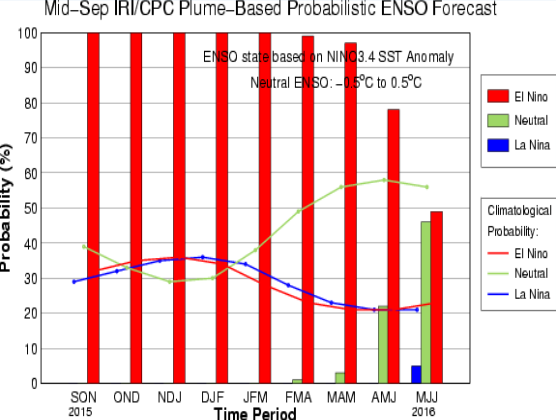Home > Blog > Climate Change
El Nino getting stronger, threatens PH until 2016

The El Niño phenomenon has become one of the most pressing global concerns today. Just recently, PAGASA has issued an update and climate outlook to prepare the public for the impending effects of El Niño, which is now being classified as a “strong” one. El Niño is a climatic condition wherein an unusual increase in sea surface temperature (SST) or warming of the ocean is observed.
The World Meteorological Organization (WMO) says a mature and strong El Niño is now in progress in the tropical Pacific, and will more likely to strengthen before the end of the present year.
WMO added that the 2015-2016 El Niño event will potentially be among the four strongest since 1950. These include the El Niño phenomena experienced during 1972-73, 1982-83 and 1997-98.
Meanwhile, according to the International Research Institute (IRI), the chance of El Niño lasting throughout the March-April-May 2016 season is greater than 95%. It also has a near 78% chance of continuing throughout the April-May-June 2016 season.

PAGASA says that from October this year until March of 2016, the weather systems that may affect the country are the Northeast Monsoon, Tail end of a cold front, Easterly Wave, Intertropical Convergence Zone (ITCZ), Low Pressure Areas (LPAs), Ridge of High Pressure Area and Tropical Cyclones.
When it comes to rainfall, the forecast of the weather bureau shows significant reduction in the coming months. This October, some areas of Mindanao are expected to receive the highest amount, while most parts of the archipelago may possibly have less rainfall.
20% of our country will experience dry conditions, dry spells and droughts. A dry condition is defined as two consecutive months of below-normal rainfall condition. A dry spell, on the other hand, happens when below-the-normal rainfall is experienced in three consecutive months, while a drought is defined as three consecutive months of way-below normal rainfall.
Currently, 23 provinces are under dry conditions, 10 under dry spells, and 6 are threatened by droughts.

According to PAGASA, four to eight tropical cylones may develop or enter the Philippine Area of Responsibility (PAR) until June 2016. Two to five tropical cyclones are expected to enter the PAR until the end of December 2015.
The public is reminded to keep monitoring updates, and to practice water conservation for preparation against the impacts of the prevailing El Niño.
Sources:
WMO
IRI
PAGASA-DOST




